Post Gupta Period UPSC Notes for IAS Exam
Post Gupta Period
The Post-Gupta period marks a transformative era in Indian history, characterized by political fragmentation and the rise of regional powers. This era witnessed significant cultural and economic developments, shaping the Indian subcontinent’s diverse heritage. Understanding this period is crucial for grasping the complexities of India’s medieval history.
- In 528CE, a consortium of North Indian kings defeated the Hunas, after which they were pushed back to Kashmir, Punjab and western India. Mandsaur Pillar inscription by a Hindu king, Yashodharman, mentions this Battle of Sondani. In this conquest, the Guptas played only a minor role.
- After this, numerous dynasties emerged, including the Maukharis of Kanyakubja(Kannauj), the Guptas of Magadha, the Gaudas of Bengal, the Maitrakas of Valabhi (Saurashtra), the Pushyabhutis of Thaneswar, etc. Many of them were originally feudatories of the Guptas. However, they declared independence as the Gupta’s political influence waned.

- Although North India was divided into numerous kingdoms, in South India, Chalukyas were emerging as a new power in the mid-sixth century. The Pallava-Chalukya contest is discussed in the following Article. This Article shall focus only on the Rise and fall of the Harshvardhan Empire(606 – 647AD).
Pushyabhuti Dynasty
- Gradually one of the post-Gupta dynasties, the Pushybhutis, ruling at Thanesar in Haryana, extended their authority over other feudatories.
- Banabhatta, the court poet of Harshavardhana, informs us that the founder king of this dynasty at Thaneshwar was Pushyabhuti. After that, a series of able kings consolidated their hold in the Thaneshwar region.
- Prabhakarvardhan was the first Pushyabhuti king to adopt the royal title of Maharajadhiraja.
- After his death, his elder son and brother of Harsha, Rajyavardhana, ascended to the throne of Thanesar.
- His sister, Rajyashri, married King Grahavarman of Kanauj (Maukhari dynasty).
- Sasanka, the king of Bengal who ruled from Gauda Region, killed Grahavarman and imprisoned Rajyashri. This caused Rajyavardhana to fight against Sasanka, but Sasanka ended up killing him too.
- In 606AD, the Pushyamitra Nobles backed the 16-year-old Harshavardhana to ascend the throne of Thanesar.
Rise of Harsha

- We know about the early history of Harsha’s reign from Harshacharita of Banabhatta and accounts of Chinese pilgrim Hiuen Tsang.
- He marched against Sasanka with the joint forces of Thanesar and Kannauj and drove him out of Kanauj, becoming its ruler. He made Kanauj the seat of his power.
- It is interesting to note that he took the title of Rajaputra instead of Maharaja.
- He humbled the later Guptas, the allies of Sasanka in this conflict, and reduced them to the position of subordinate Feudal lords. Thus, he could bring all of the Northern plains under one rule, declaring himself Sakalottarpathanath (lord of all of the North).
- The extent of his Empire:
- Parts of the present-day states of UP, south Bihar, and Odisha appear to have been under Harsha’s control. He inherited Thanesar, eastern Rajasthan and parts of eastern Punjab. Bhaskaravarman, the ruler of Kamarupa, was Harsha’s subordinate ally, and he also had influence over the kings of Jalandhar and possibly Kashmir.
- In Eastern India, he faced opposition from Sasanka of Gauda, a Shaivite, who cut off the Bodhi tree at Gaya. On the other hand, Harshvardhana patronised Buddhism in Eastern India.
- In the south, the Narmada served as the boundary between him and Pulkeshin II. Pulkeshin stopped his southward advance on the Narmada River and ruled over a great part of Maharashtra, with his capital at Badami in the Bijapur district of Karnataka. From the account of Xuan Zang or Hiuen Tsang, it appears that Harsha took the initiative, but his campaign against Pulkeshin was without much success.
Kannauj – a new seat of power
- Kanauj (Kanyakubja) replaced Pataliputra as the most important place in the region.
- With the decline in trade, money became scarce, and officers were paid through land grants; Pataliputra lost its relevance, and power shifted to military camps (Skandhavaras).
- Strategic Importance of Kannauj: It was surrounded by a long stretch of land and was on higher ground than the surrounding areas. This elevated area was easily fortifiable, and the surrounding pains were easily taxable.
- Controlling Kannauj and declaring themselves Sakalottarpathanatha became a matter of pride for kings in the later centuries, as seen in the 8th century tripartite struggle for Kannauj.
Harshavardhana Empire Administration
- Harsha’s empire was governed on the line of the Guptas.
- Feudal Setup:
- However, his had become more feudal and decentralised, making the empire more vulnerable.
- The priests continued to receive land grants, and the feudal practice of rewarding and paying officers with land grants seems to have begun under Harsha.
- The Chinese pilgrim Hiuen Tsang tells us that the revenue of Harsha’s kingdom was divided into four parts. One part was earmarked for King himself, scholars received another, public servants and officials received a third, and religious purposes received a fourth.
- In his empire, it seems law and order were not well maintained; Hiuen Tsang, a state guest, was robbed of his belongings. However, he reports that severe punishment was inflicted for the crime.
Account of Hiuen Tsang
- He left China in 629 CE and travelled all the way to India; he returned to china in 645 CE. He had come to study in Nalanda and to collect Buddhist texts from India.
- Under his influence, Harsha became a great patron of Buddhism and made generous donations in its favour. He has given a grand description of the Buddhist assembly at Kanauj (Kanyakubj) during Harsha’s reign.
- He also mentions that the Hinayana and the Brahmanas resented Harsha’s patronage of the Mahayana. However, he also gives an account of the Prayaga Assembly, where Harsha worshipped Buddha, Shiva and the Sun and distributed charity to the followers of all faiths.
- He calls Shudras agriculturalists, which is significant since earlier texts represent them as serving the three higher varnas.
- The Chinese pilgrim observed untouchables such as scavengers, executioners etc. They lived outside the village and took garlic and onion. The untouchables made tapping sounds as they entered the town to warn residents to stay away from them.
Religion and Lierature
- During the time of the Hiuen Tsang’s stay in India, Eighteen Buddhist sects existed.
- The most famous centre was Nalanda, which had a great Buddhist university. It is said to have as many as 10000 students, all monks. They were taught the Buddhist philosophy of Mahayana school.
- Harsha followed a tolerant religious policy. From Shaivism, he converted to Buddhism and convened a grand assembly at Kanauj.
- Harsha is known not only for his patronage and learning but also for authoring three dramas – the Priyadarshika, the Ratnavali and the Nagananda. However, this claim is disputed by several medieval scholars.
- Banabhatta, the court poet, wrote the biography of Harsha in Harshacharitam. He also wrote Kadambari, a romantic novel in Sanskrit; it was completed by his son Bhushanbhatta since Banabhatta had died before its completion.
Evaluation of Harsha’s Reign
- Harsha’s reign marks the rise of new political centres such as Kannauj and Gwalior. It also marks the growth of fort architecture in India.
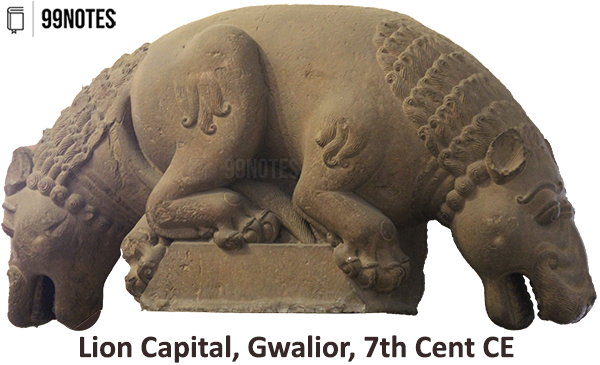
- He died in 647 AD without any heir to the throne after ruling for 41 years. His empire disintegrated soon after his death.
- Harsha is called the last Hindu emperor of India; however, this cannot be true.
- He was neither a staunch Hindu nor did he rule all over India.
- His sphere of influence was limited to northern India.
- Furthermore, there were many great Hindu empires after Harsha having greater sphere of influence. For example the Cholas in the 10th century and Marathas in the 18th century had greater territories than Harshavardhan’s.
Explore additional significant articles on Ancient Indian History listed in the table below:
| Stone Age | Harappan Civilisation |
| Vedic Period | The Mahajanapadas |
| Mauryan Empire | Understanding Mauryan Society |
| Gupta Empire | The Deccan States of Ancient India |

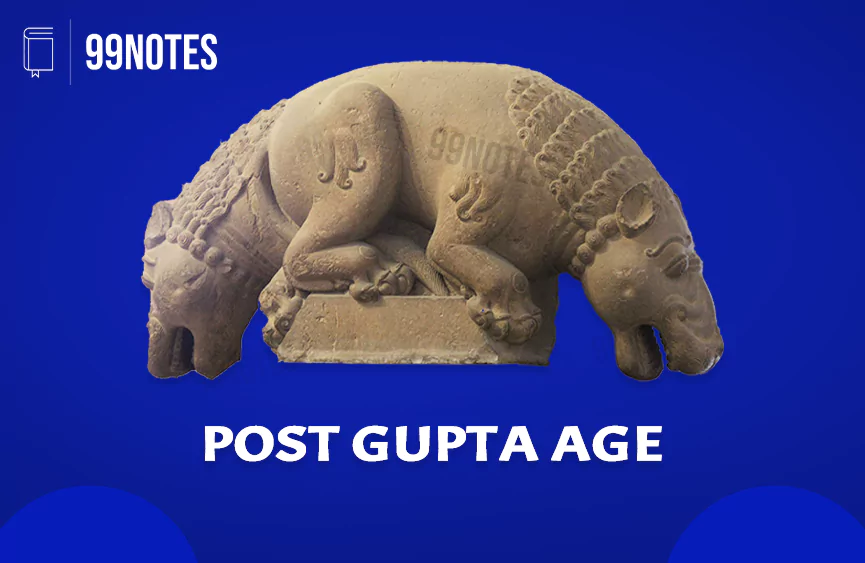
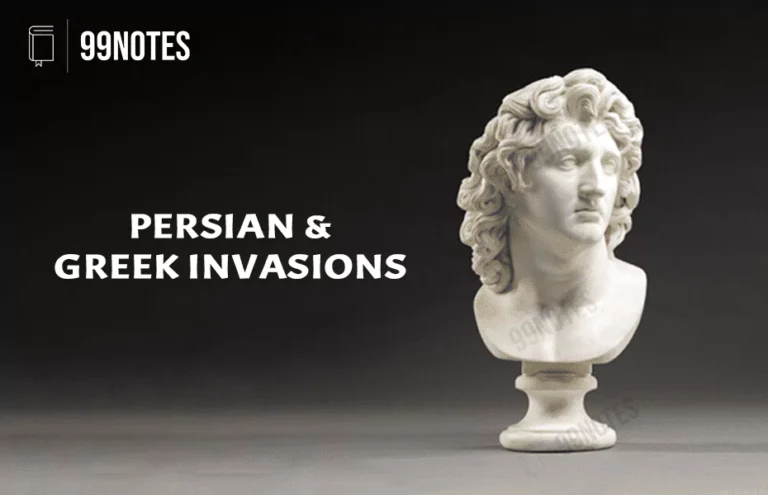
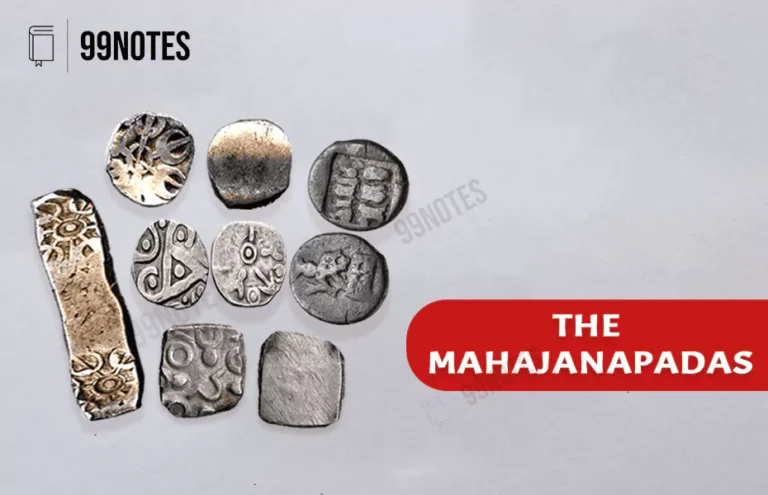
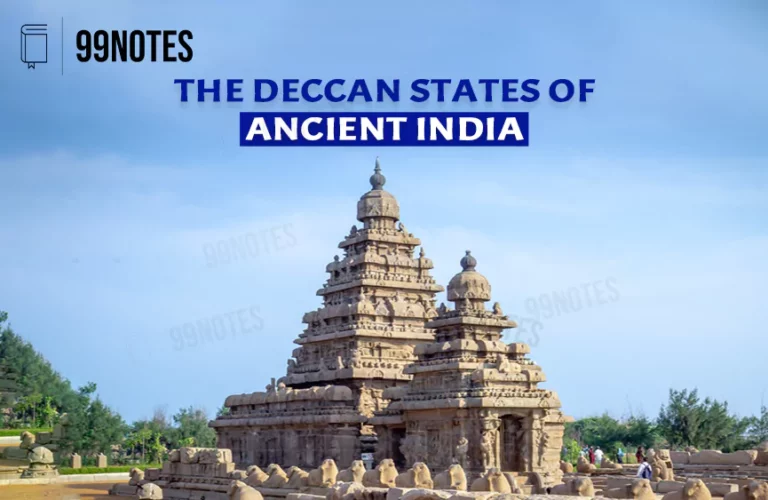

![Post Mauryan Period: Shunga, Kanva Dynasties &Amp; More [Upsc Notes] | Updated July 27, 2024 Post Mauryan Period: Shunga, Kanva Dynasties & More [Upsc Notes]](https://99notes.in/wp-content/uploads/2023/04/post-mauryan-age-99notes-upsc-1-768x495.webp)
![Sangam Age: Literature, Map, &Amp; Dynasties [Upsc Exam Notes] | Updated July 27, 2024 Sangam Age: Literature, Map, &Amp; Dynasties [Upsc Exam Notes]](https://99notes.in/wp-content/uploads/2023/04/megalith-sangam-age-99notes-upsc-768x495.webp)